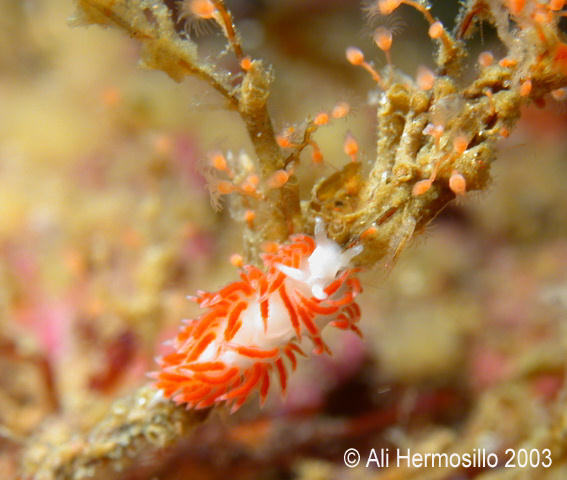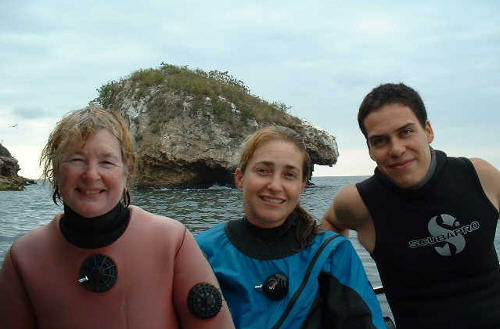 |
Flabellina bertschi
Photos couresty of Ali Hermosillo and Pedro MedinaBanderas Bay, Puerto Vallarta, Mexico
Flabellina bertschi Gosliner & Kuzirian, 1990
The know distribution of this nudibranch is within the Gulf of California and in the outer Coast from Punta San Andrés to Panama and recently reported from Ecuador in Bill Rudman´s Sea Slug forum .
It is a small aeolid measuring up to 15 mm in lenght. It was named in honour of our dear friend, noted baja traveler, and nudibranch expert Dr. Hans Bertsch.
In Bahia de Banderas, it is one of the most abundant aeolids (third to Flabellina marcusorum and Flabellina telja ). Flabellina is the genus with more species in Bahia de Banderas (7 altogether). Flabellina bertschi is usually found in clusters, living and feeding on various species of hydroids. Generations seem to overlap since I have not observed a distinct change in abundance throughout the year. Flabellina bertschi lays its white string like eggs on the hydroids.
At a first glance Flabellina bertschi can be confused with another little white and red colored panamic aeolid: Noumeaella rubrofasciata Gosliner, 1991. If one looks closer (or with a magnifying glass when they are very small), they are very different. Flabellina bertschi has simple rinophores and white cnidosacs (tips of the cerata) whileN. rubrofasciata´s rinophores are perfoliated and larger compared to the body of the animal and the tips of the cerata are orange. N. rubrofasciata bears an orange stripe on the head. The cerata are more numerous and slender in F. bertschi than N. rubrofasciata.
Flabellina bertschi and Noumeaella rubrofasciata are often seen close to a similarly colored amphipod . The amphipod is an example of "Batesian mimicry", where the tasty soft bodied amphipod benefits from looking like the aeolid armed with nematocysts in its cerata. For those of you on broad band, tune into a short video clip (6 Megs) in Quicktime format filmed by Pedro Medina of this interesting behavior.
REFERENCES:
Gosliner, T. M. (1994) New records of Flabellinidae (Opisthobranchia: Aeolidacea) from the tropical Americas, with descriptions of two new species. Proceedings of the California Academy of Sciences, 48: 171-183.
Gosliner, T. M. & A. M. Kuzirian. 1990. Two new species of Flabellinidae (Opisthobranchia: Aeolidacea) from Baja California. Proceedings of the California Academy of Sciences, 47: 1-15.
Puerto Vallarta, Mexico
Sept. . 2003
Sandra Millen, Ali Hermosillo, and Pedro Medina
Puerto Vallarta, April 2002

|
Webmaster's Notes: In April of 2002 I was invited down to Puerto Vallarta by Ali and Roberto to participate in a branching field trip along with Sandra Millen of Vancouver, British Columbia. Sandra had arrived a good week or so before me and it was evident that Ali's unbridled enthusiasm was wearing Sandra out and I could envison myself as next in line. What the heck, I packed an ample supply of geritol to get through the trip! What I saw in the way of Pan American branchs at Bahia de Banderas exceeded my wildest expectations. Sandra and myself were both beset by camera problems, I had little enough time to see all the branchs Ali and all the mexican branchers were coming up with. The camera shutdown had mixed blessings. Going in without it enabled sufficient time to ponder all the magnificent animals Ali and gang were finding! I would like to take this opportunity to totally endorse the dive operation Ali and Roberto's are associated with
Vallar-Tech in Puerto Vallarta for any nudiphile who would like to experience the Pan American branching scene! Their operation is first class and Ali and associates will certainly find enough branchs to rekindle memories of the trip for years to come. They can arrange hotel accommodations very convenient to the dive operation.
Ali can be contacted at gueri25@hotmail.com |
"...I take pictures with a Nikon Coolpix 995 (3.4 megapixels). For the underwater photos I use an Aquatica housing and a 10 watt HID light. For the tub shots I use a couple of 50 watt cold fiber optic lights and a 5x magnifying glass held in front of the camera lens.
I am in the fourth semester of my Ph.D. I have been surveying Bahia de
Banderas now for 18 months. After the first year I was able to pick 10
sites to visit every month in order to monitor the communities of
opisthobranchs there. In this 18 months of research, my opisthobranch
species count for the bay is 126. I have recorded over 12,000 specimens
with data such as depth, size and substrate among others..."
Puerto Vallarta, Mexico
Sept. , 2003
Taxonomic information courtesy of:

David W. Behrens
Author:
Pacific Coast Nudibranchs
Send Dave mail at dave@seachallengers.com
|
